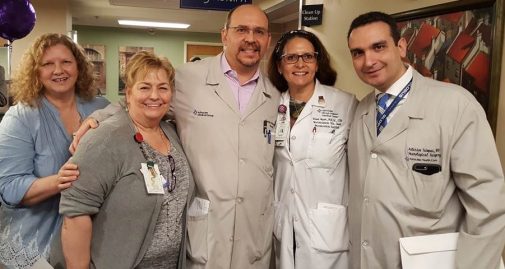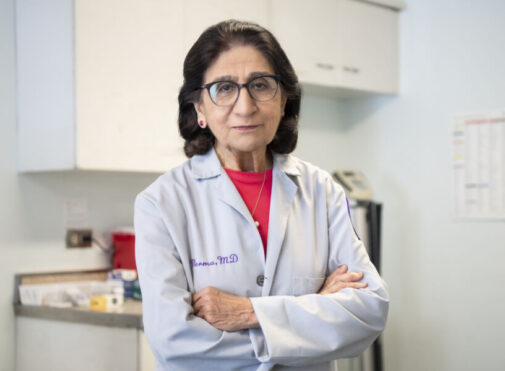Stroke patient prevails in a race against time
September 20, 2016 should have started just like any other for Andrea Skillman. But she realized something was not quite right as she woke up that warm fall morning.
First, her right arm felt funny, like it had become dead weight. Then, Andrea looked in a mirror and noticed the right side of her face drooped slightly. She tried to speak but couldn’t utter any words.
“I’ve been working at Advocate Illinois Masonic Medical Center for 25 years, and as an associate, I receive mandatory safety education every year. That morning, when my face drooped, my arm felt dead and I couldn’t talk, I knew what was happening,” Andrea says. A blood clot was blocking blood flow to her brain–she was waking up with an ischemic stroke.
Stroke is the fifth leading cause of death and the leading cause of disability in the United States. The American Stroke Association utilizes the acronym FAST to help the public quickly identify stroke symptoms:
F: Face drooping
A: Arm weakness
S: Speech difficulty
T: Time to call 911
The time aspect is critically important: Care teams must be able to respond within a certain time window in order to re-establish blood flow to the brain and prevent permanent dysfunction or loss of life. It was this FAST acronym which triggered Andrea to quickly recognize she was suffering from a stroke.
Andrea was brought to Illinois Masonic’s emergency department, where an alert was called for the hospital’s multidisciplinary stroke team. After assessing Andrea’s condition, the team made the joint recommendation that she undergo endovascular treatment to remove the clot in her brain.
The team performed a mechanical thrombectomy, which involves inserting a thin mesh tube through an artery in the patient’s groin and guiding it through the body toward the clot. Once it reaches the clot, the mesh expands and catches it like a trap, and then it is carefully pulled back and out of the body.
“In most stroke cases, the neurologist can establish the time frame of a stroke and follow an established treatment protocol, says Dr. Asterios Tsimpas, a cerebrovascular and endovascular neurosurgeon at Illinois Masonic. With a wake-up stroke, you don’t know what time the stroke started, so stroke teams have to use strong clinical judgement on what treatment path to take,” he says.
Dr. Timothy Mikesell, a stroke neurologist at Illinois Masonic, says the stroke team’s focus on the continuum of care serves as the foundation of the team’s efforts. “As some of our stroke patients who meet criteria for intervention are cared for from the emergency department to interventional radiology for endovascular treatment to the intensive care unit to a heart monitored unit and then acute rehab care, it is part of our philosophy of care that the patients seamlessly transition into each expert’s hands.”
It takes a village
Within 24 hours of her procedure, Andrea was completely back to normal. She can move her arm and speak as clearly as before, and she’s going on vacation to Florida with her extended family.
Reflecting back on her time as a stroke patient, she feels an overwhelming sense of gratitude that she had such a strong and compassionate team care for her.
“It wasn’t just one person who helped me get better,” Andrea says. “Dr. Mikesell, Dr. Tsimpas, my primary care physician Dr. Steven Potts and the emergency department have this incredible partnership. And there were also the techs and nurses in all of the units and departments who made me feel so secure. I feel so lucky that I was cared for here. I don’t know what my outcome would have been if I wasn’t.”
Advocate Illinois Masonic Medical Center is a Primary Stroke Center, a designation reserved for hospitals that abide by a higher quality standard of stroke care and education. Dr. Mikesell and Dr. Tsimpas serve as the physician leaders of the hospital’s multidisciplinary stroke care team.



















Thank you for posting. I think stroke education is so important! I hope my little story impresses people to never hesitate to take someone to get checked out as soon as possible, don’t wait.
I am so very fortunate and blessed.